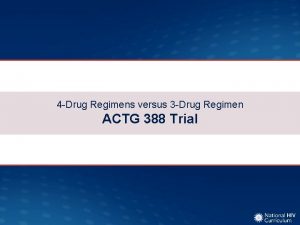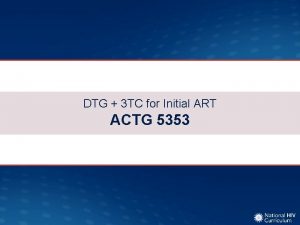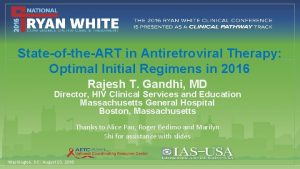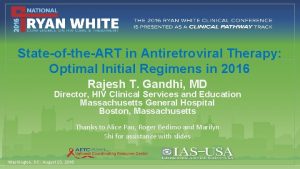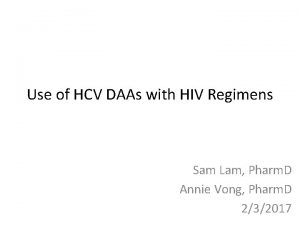ClassSparing Regimens for Initial Treatment of HIV ACTG







- Slides: 7

Class-Sparing Regimens for Initial Treatment of HIV ACTG 5142

EFV + NRTIs versus LPV/r + EFV ACTG 5142: Study Design: ACTG 5142 • Background: Randomized, phase 3 trial comparing the efficacy, safety, and tolerability of 3 different class-sparing ARV regimens in antiretroviral naïve adults and adolescents with HIV • Inclusion Criteria (n = 753) - Age ≥ 13 years - Antiretroviral naïve - HIV RNA ≥ 2, 000 copies/m. L - No CD 4 restrictions • Treatment Arms - EFV 600 mg QD + 2 NRTIs - LPV/r 400/100 mg BID + 2 NRTIs - LPV/r 533/133 mg BID + EFV 600 mg QD Source: Riddler SA, et al. N Engl J Med. 2008; 358: 2095 -106. PI-Sparing Group Efavirenz + 2 NRTIs (n = 250) NNRTI-Sparing Group Lopinavir-ritonavir + 2 NRTIs (n = 253) NRTI-sparing Group Lopinavir-ritonavir + Efavirenz (n = 250)

EFV + NRTIs versus LPV/r + EFV ACTG 5142: Results Week 96: Virologic Response EFV + 2 NRTIs 100 93 80 LPV-RTV + 2 NRTIs 92 86 EFV + LPV-RTV 89 Patients (%) 77 60 40 20 0 <200 copies/m. L HIV RNA Threshold Source: Riddler SA, et al. N Engl J Med. 2008; 358: 2095 -106. <50 copies/m. L 83

EFV + NRTIs versus LPV/r + EFV ACTG 5142: Results Virologic or Regimen Failure EFV + 2 NRTIs LPV-RTV + 2 NRTIs EFV + LPV-RTV Patients (%) 100 80 60 50 38 37 40 43 29 24 20 0 Virologic Failure Regimen Failure Virologic failure = lack of suppression of plasma HIV-1 RNA by 1 log 10 or rebound before week 32 or a lack of suppression to <200 copies/m. L or rebound after week 32. Regimen failure = first of either virologic failure or toxicity-related discontinuation Source: Riddler SA, et al. N Engl J Med. 2008; 358: 2095 -106.

EFV + NRTIs versus LPV/r + EFV ACTG 5142: Results Summary of Resistance Mutations at Time of Virologic Failure* EFV + 2 NRTIs LPV/r + 2 NRTIs LPV/r + EFV (%) (%) Virologic failure events 24 37 29 Any mutation 48 21 70 NRTI-associated mutation 30 19 11 M 184 V 17 17 0 K 65 R 7 0 2 NNRTI-associated mutation 43 3 66 K 103 N 24 0 55 Any protease mutation 85 78 80 Major protease mutation 0 0 4 Mutation associated with 2 classes 26 1 7 Variable *Percentages of patients with mutations were calculated for those who had an available genotype at the time of virologic failure. Source: Riddler SA, et al. N Engl J Med. 2008; 358: 2095 -106.

EFV + NRTIs versus LPV/r + EFV ACTG 5142: Conclusions: “Virologic failure was less likely in the efavirenz group than in the lopinavir-ritonavir group. The virologic efficacy of the NRTI-sparing regimen was similar to that of the efavirenz regimen but was more likely to be associated with drug resistance. ” Source: Riddler SA, et al. N Engl J Med. 2008; 358: 2095 -106.

Acknowledgment The National HIV Curriculum is an AIDS Education and Training Center (AETC) Program supported by the Health Resources and Services Administration (HRSA) of the U. S. Department of Health and Human Services (HHS) as part of an award totaling $800, 000 with 0% financed with non-governmental sources. This project is led by the University of Washington’s Infectious Diseases Education and Assessment (IDEA) Program. The content in this presentation are those of the author(s) and do not necessarily represent the official views of, nor an endorsement, by HRSA, HHS, or the U. S. Government.








